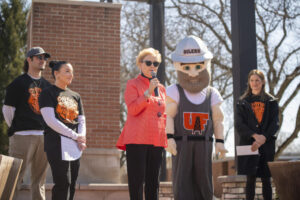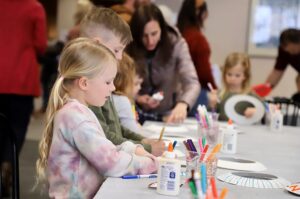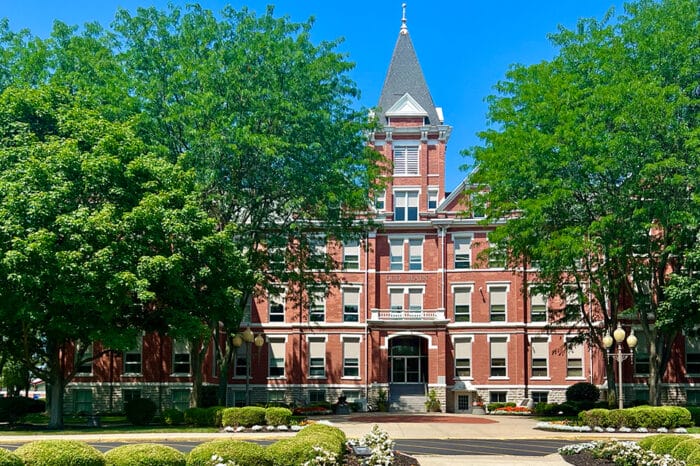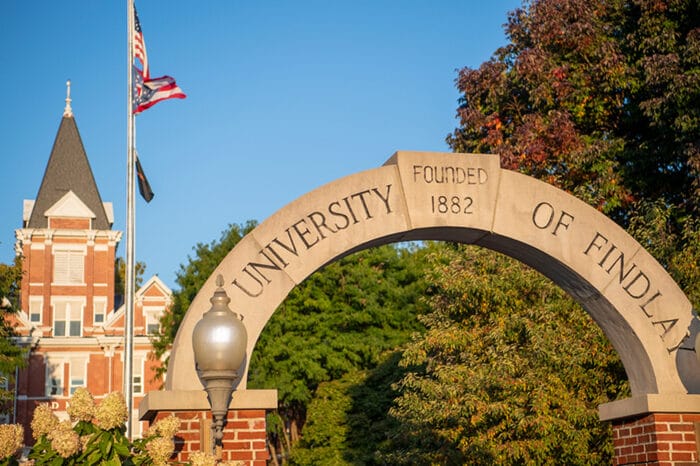Education Alumni Help Schools Develop and Communicate a Cohesive Mission

Imagine beige walls surrounding impossibly uncomfortable desks that have been placed in rows and filled with apathetic students listening to a teacher monotonously drone on. This is high school as we see it in television shows, movies and for many people, in their community. In a field that struggles with teacher retention and graduation rates, it’s easy to see why this environment is uninspiring. Now, imagine a school where teachers have a sense of autonomy, students can choose their own path and anyone who interacts with the school feels a sense of pride and excitement. This is the vision that Findlay alumni Scott Grant Ed.D. ’04, ‘06 and Brent Wise, M.E. ‘04 bring to schools through their consulting business Triple Threat Leadership (TTL).
TTL’s main mission is to add value, build relationships and create opportunities strategically through energy, enthusiasm and engagement. Since the creation of TTL by Grant during the last semester of his doctoral program, he has worked with over 160 high school groups, colleges and organizations on personal branding and social media awareness, and has assisted many on how to clarify and showcase their values and mission through marketing principles. Since TLL’s inception, Grant has also given multiple interviews and presentations, including a TEDx talk in 2018. Wise joined the business in the past year to help develop new opportunities and impact organizations on a larger scale.
Each seminar is based on the needs of the audience, so no two are precisely alike. To get the full experience of what these two Findlay alumni can do to change a school, I sat in on a presentation given to Hancock County principals and superintendents. Seeing the process at work illuminated the impact that a little guidance can have on the direction of an entire district. Over the following two hours, Grant and Wise led seasoned administrators to not only envision their school in a new light, but to share that vision with their students, teachers and community.
 12:00 p.m. – “Branding and social media are hot topics in education right now, but you can’t just create video and push it out. There needs to be strategy there,” Grant says as he opens the session. “You need to know who you are and what you believe, and figure out how to let others know about it.” The partners introduce themselves and their D2A2 branding process: Dreaming, Developing, Activating & Amplifying.
12:00 p.m. – “Branding and social media are hot topics in education right now, but you can’t just create video and push it out. There needs to be strategy there,” Grant says as he opens the session. “You need to know who you are and what you believe, and figure out how to let others know about it.” The partners introduce themselves and their D2A2 branding process: Dreaming, Developing, Activating & Amplifying.
12:15 p.m. – Before dreaming even begins, Wise has the attendees take a hard look at the current state of their schools. After all, you cannot move forward if you don’t know where you are. Through a meditation exercise, attendees are asked to envision their school through the eyes of their constituents. Wise guides them through reflective questions like, “Is someone there to greet you? Are your mission and values on display? Are the hallways filled with enthusiastic students and teachers?” Gazing around at the room full of administrators, their faces give tells as to the state of their schools. Neutral faces slowly transform into full grins and relaxed posture, while others degrade into grimaces and furrowed brows. For those who are unhappy, Wise offers encouragement reminding them that today’s session is about finding a way for them to feel pride when people interact with their district.
12:22 p.m. Dreaming – Grant sparks the dreaming phase by asking them to think of the energy they create within their school and explaining that the energy they create is their unique value proposition (UVP). It’s a fairly logical approach: your schools’ values differ from others, and that is what makes you unique. You showcase your values through experiences. Your experiences generate energy. Together, your values, experience and energy are something tangible you can use to differentiate yourself. This becomes the promise that you make to your constituents. “As an administrator, you have the largest hand in what this process looks like moving forward,” says Grant. “If you are not excited about your values and building your experience around them, it’s just not going to work.” As he passes the figurative baton to Wise, it appears that they have taken on different aspects of the presentations, Grant focusing on the business principle and Wise showcasing application within schools. Wise took the theoretical business principles and showed the attendees how they can be used in schools by showcasing three case models. He says the danger of not applying these principles boils down to this, “Your students and teachers are looking for meaning and purpose. If they can’t find it at your school, they are going to look elsewhere.”
 12:50 p.m. Developing– Now that they’ve had a chance to dream about what they want their school to be like, it is time to develop. In this phase, a blueprint of experiences showcasing the school’s values is created. These experiences are going to be what helps make the dream come true. In a particularly interesting case study, Wise discusses a family with a child in high school, middle school and an elementary school. While the students’ experiences are going to be different, they should embody the same values. Each of those students, no matter what age, should feel connected to the mission and feel like they are part of the same team even if they attend different schools.
12:50 p.m. Developing– Now that they’ve had a chance to dream about what they want their school to be like, it is time to develop. In this phase, a blueprint of experiences showcasing the school’s values is created. These experiences are going to be what helps make the dream come true. In a particularly interesting case study, Wise discusses a family with a child in high school, middle school and an elementary school. While the students’ experiences are going to be different, they should embody the same values. Each of those students, no matter what age, should feel connected to the mission and feel like they are part of the same team even if they attend different schools.
Those in attendance become animated at this point and discussion breaks out as to the cost of implementing a whole new message. Wise directs them back to the heart of the seminar: marketing often has costs associated with it, but branding pushes deeper into the culture of the school and that is what they are implementing. Grant elucidates, “At its core, branding is making, communicating and delivering a promise,” he says. “Marketing is the communicating and connecting part, but you need to figure out what that promise is in the first place.” Wise gets them back on track explaining that millennial students are looking for the same personalization, aesthetics and branding they get in their day-to-day life in their schooling. Adapting spaces within your school is an easy way to bring them what they are looking for at a low cost and can be an outward show of your schools’ values by letting the students be a part of the process of branding classes and improving school aesthetics.
1:33 p.m. Activating – Being a professor in Findlay’s College of Business, Grant certainly has a lecture prepared about the ins-and-outs of brand activation. Luckily for this group of school administrators, he cuts through the technical jargon and sums it up in one statement: Increase awareness through an event. School administrators and teachers do this all the time, but often without any strategy, so the efforts end up being disjointed and ineffective. According to Grant, the goal of the activation phase is to essentially create a glass wall so people can see inside the beliefs, values and environment of the schools. When considering what kind of activities to implement in their schools, Wise asks the attendees, “What do you believe, and how are you living it to your students, teachers and families?” He emphasizes that you can do all the social media gimmicks in the world, but if you’re not living what you are saying then no one will engage with that.
1:45 p.m. Amplifying – In this final step, which most people consider traditional marketing, the group process ends. Each school district must consider who they are and what kind of method best suits them. The whole process is not a one-size-fits-all fix, but this stage in particular should be tailored to the individual school district’s needs. Grant offers some final suggestions like making a visual style guide and various apps and programs to make the amplification process easier. By ending with how to market their message, they once again emphasize the point that understanding the organization’s values and goals always comes first. There is no amplifying if there is nothing to amplify. This ends the session.
Grant and Wise don’t just preach this vision, they live it. Wise has previously filled the role of director of Innovation and Extended Learning at the Innovative Learning Center in Hilliard City Schools, and currently is the director of Innovation and Strategic Initiatives at Mariemont City Schools in Hamilton County, Ohio. Throughout his career, he has collaborated with fellow educators to develop new education models for students and teachers. While at Hilliard, he created a pathway system unique compared to the average public school. Upon entering high school, students had the opportunity to choose from five paths: personal success, college jumpstart, young professionals, global and imagination. The path they chose helped determine what courses and activities they could pursue for post-graduation success. At Mariemont, he has overseen the implementation of a class schedule where each Friday afternoon, students take a course of their choosing. These courses are created by a teacher in whatever subject they are passionate about. Previous courses have included campfire cooking, where teachers build campfires outside and teach students how to cook meals on them, and website design, where students code their own website from the ground up. These examples are small reflections of the work Wise does every day to improve the education experience for his students, teachers and community.
Grant currently works with college-level students as an assistant professor of business at University of Findlay where he has played an instrumental role in the creation of the Oiler 10, a student-run marketing and consulting agency. The course, which is now in its third year, was born out of a desire to shake things up. Grant was seeking inspiration for alternative teaching methods that featured more hands-on learning. Ultimately, he wanted to create an environment in which students from different backgrounds and skill sets, as well as many who had less time to take advantage of internship opportunities during the school year, could apply and take ownership of actual work, and use it to land jobs after graduation. Previous clients from throughout the country include OMG…It’s Gluten Free, Body Art Protein, Right to Win, DNC Hydraulics and more.
Both credit their time at Findlay as the reason for their success today. “What I’ve been able to do business-wise is 100 percent because I started in education at Findlay,” said Grant. “It’s not about me passing along information, it’s about me helping students figure out who they want to be. All that is transferable to business because at the end of the day, it’s managing and helping people and organizations get better.” Wise returns to Findlay regularly as a guest speaker to undergraduate education students to impart his knowledge of the field. He says that Findlay prepared him to be an educator by providing him with multiple field experiences throughout his entire college career. “The relationships I made with the University, my professors and the cohort I went through with are some long lasting friendships that I still rely on today as my personal network,” Wise said.














